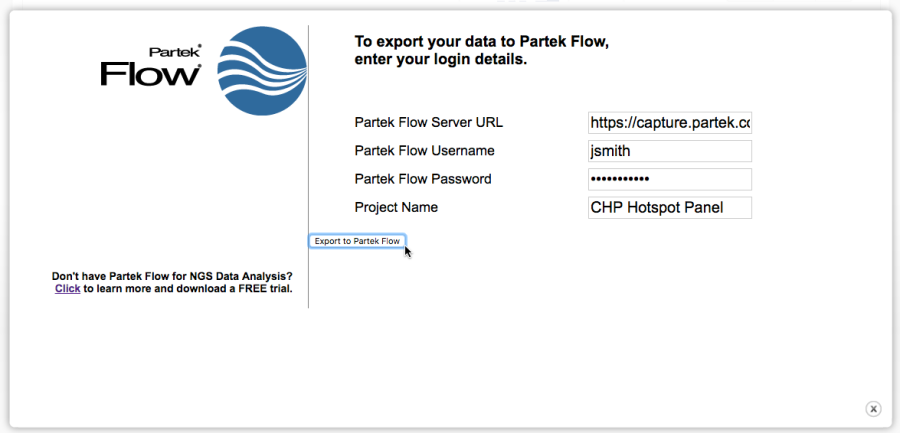Page History
...
| Numbered figure captions | ||||
|---|---|---|---|---|
| ||||
...
The Project Name field will be used in Partek Flow to create a new project where the run results will be exported. However, if a project with that name already exists, the samples will be added to that existing project. This enables you to combine multiple runs into one project. Project Names are limited to 30 characters. The default project name is the Run Name.
When ready, click Export to Partek Flow to proceed. If you wish to cancel, click on the X on the lower right of the dialog box.
Note that configuring the Plugin from a report (Figure 15) is very similar to configuring it as part of a Run Plan (Figure 10) with two notable differences:
- The Check configuration has been replaced by Export to Partek Flow button, which when clicked, immediately proceeds to the export.
- The Save changes button has been removed so any change in the configuration cannot be saved (compared to editing a run plan where plugin settings are saved)
Once the plugin starts running, it will indicate that it is Queued on the upper right corner of the Plugins Summary (Figure 16). There will also be a blue Stop button to cancel the operation.Figure 16:
| Numbered figure captions | ||
|---|---|---|
|
Click the
| |||
...
Click the Refresh plugin status button to update. The plugin status will show Completed once the export is done and the data is available in Partek Flow (Figure 11).
...
Information on Data transferred by the
...
Partek Flow Uploader
The Partek Flow Uploader plugin sends the data unaligned bam files to the Partek Flow server. Once transferred, Partek Flow then proceeds to validate the data within a Project.
There may be some occasions when the plugin is already done transferring the data but Partek Flow is still validating it. This can easily be checked by expanding the sample table. To do so, open the project in Partek Flow, select the Data tab, and click the Show data files link on the lower left of the table Each filename generated by the run will create a sample of the same name in the Data tab (Figure 17).
Figure 17: Expanding the Expanded Sample Table to display the showing Data files
If the data is still being validated, the table will have empty cells in the Files column (Figure 18). Refresh the page and make sure the table is complete before proceeding.
Figure 18: Data still being validated and the project is not yet ready
Once data validation is done, the table should be complete (Figure 19).
Figure 19: All files are validated and the project is ready
If the validation fails to succeed, some files will not be imported (cells will remain blank) and there will be a notification in the Log Tab. Refer to the Run Report in the Torrent Browser to check if there was any issue in the run.
The Sample Table in Partek Flow (Figure 19) has corresponding information in the Run Report of the Torrent Browser (Figure 20).
The Sample name in Partek Flow corresponds to the Sample column in the Output files section of the Run Report. The unaligned BAM (UBAM) file for each sample has been transferred to Partek Flow and appears in the bam (Files) column. The Run Name is added as a sample attribute.
For reads that have no barcodes, the Torrent Browser does not assign a sample name (shown as None on the first row of Figure 20). These reads are also transferred to Partek Flow. For clarity, the plugin assigned them to a sample named No barcode (first row in Figure 19).
Figure 20: Torrent Browser run report showing corresponding items in the Partek Flow Sample table in red
To add multiple Runs to the same Partek Flow Project, configure the plugin and use the same Project Name (Figure 10 or Figure 15). The samples will be combined in the same project. Figure 21 shows a Partek Flow Sample table from two Ion Torrent Runs (note the Run Name column).
If two different runs have the same sample names, each would appear as a separate row with names appended (e.g., Sample 1.1).
Figure 21: Partek Flow project containing data from multiple runs. Duplicate samples are appended by a dot followed by a number
Samples you do not wish to include in your analysis (particularly those with no barcodes) can be easily deleted by clicking the gear icon next to the sample name and selecting Delete sample (Figure 22).
Figure 22: Deleting samples in Partek Flow
The data transferred by the Partek Flow Uploader is stored in a directory created for the Project within the user's default project output directory. For example, in Figure 19, the data for this project is stored in:
/home/flow/FlowData/jsmith/Project_CHP Hotspot Project
...

